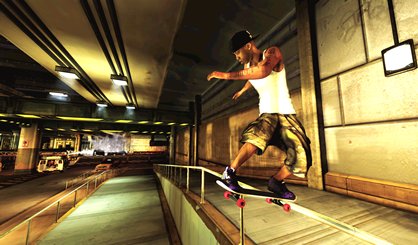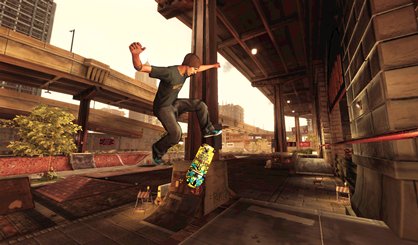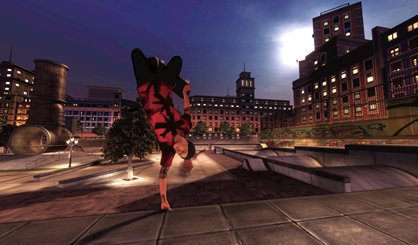Tony Hawk Ride: hands-on
The king of skate is back after a two-year absence, and he’s brought a little plastic buddy
How much space is left in your living room? That’s the question you need to ask yourself when you think about Tony Hawk Ride. Unlike games like Guitar Hero and DJ Hero, where the giant, ugly set of peripherals are integral to the experience, you get the feeling that the Ride board isn’t necessary. It’s a novelty. A bell. A whistle.

Above: Note -screens taken from the 360 version
That said, it works pretty well. Our only memory of seeing the game in action at E3 was watching a journalist desperately scratching his foot against the floor as his on-screen skater repeatedly pushed himself into the wall of a storm drain. It was a mess, and left us less than thrilled. A few months later and we’re hands (or should that be feet)-on with the game in a mercifully behind-closed-doors demo at GamesCom. And things are looking up for the Birdman.
We’re let loose on a fantasy castle style stage in what we’re told is Toledo in Spain. Next to EA’s Skate games the cartoony visuals look, well, awful. Very reminiscent of Downhill Jam on Wii, Ride has definitely opted for the less realistic look – presumably to avoid isolating the casual and family gamers this title is laser-targeted at. The stage is unimaginatively designed too, and it’s nothing more than a linear run from top to bottom with grinds and jumps liberally scattered throughout. There are moments when the course splits into three paths, but they’re all fairly similar routes with some supposedly tougher than others. Along the way we trigger an event causing a section of castle to topple in slow motion behind us. Far from adding ‘a thrill,’ it interrupted our flow, and we wobbled on the board as we waited until the game returned control to us.

Importantly though, the peripheral worked well. It responded well to our leaning back, dutifully flinging our skater into the air for a jump, and the turning never felt too sensitive or sluggish. Once in the air, we waved our hands in front of the board’s infrared sensors and, nine times out of ten, our on-screen dude pulled off a nifty grab. Even then, the tricks we missed could be attributed to us not waving at the right bit of the board, so in terms of responding to player inputs, the peripheral gets top marks. Good job really, because you can’t actually play Ride without it. It’s no real loss though: the game would just be too simple with the regular control input.
In all, there are six real world locations to skate in, although from what we’ve seen these areas will be inspired by places like LA and Frankfurt instead of recreating actual sections of each city. Within these locations, there are various events to take place in, like Speed Run (get from the top of a run to the finish, collecting time bubbles to keep your overall time low), trick (high scores), and challenge (complete certain skate tasks). If you don’t fancy any of that you can just free skate, making it feel more like small slices of the traditional Pro Skater series.
As you’d expect, there are various customisation options for both player and board, and 15 celeb skaters will be available for you to control mid-game. And yes, Tony himself is in there, so you can attempt to recreate and even better his infamous X-Games 900-degree spin run.

However, even with all the usual Hawk window dressing, Ride is failing to impress as a game. The board may work well as a peripheral, but unless the in-game stages get more imaginative and, dare we say it, exciting, it’ll soon become just another plastic peripheral gathering dust in the corner of your room.
Sign up to the GamesRadar+ Newsletter
Weekly digests, tales from the communities you love, and more
Sep 28, 2009


